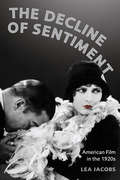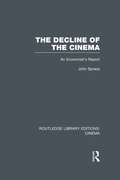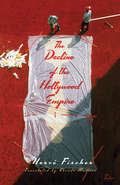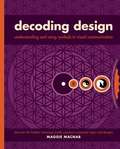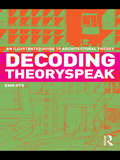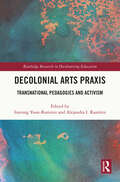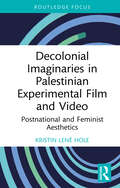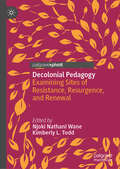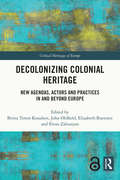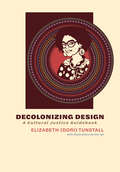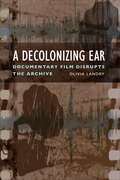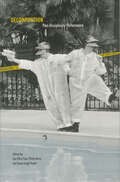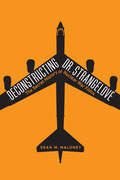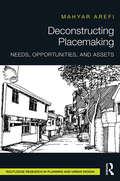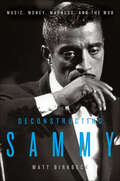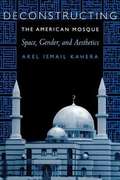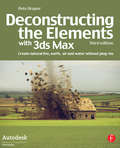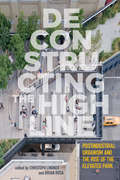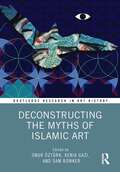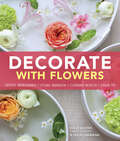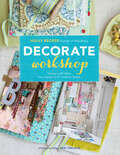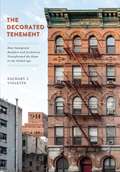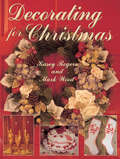- Table View
- List View
The Decline of Sentiment: American Film in the 1920s
by Lea JacobsThe Decline of Sentiment seeks to characterize the radical shifts in taste that transformed American film in the jazz age. Based upon extensive reading of trade papers and the popular press of the day, Lea Jacobs documents the films and film genres that were considered old-fashioned, as well as those dubbed innovative and up-to-date, and looks closely at the works of filmmakers such as Erich von Stroheim, Charlie Chaplin, Ernst Lubitsch, and Monta Bell, among many others. Her analysis--focusing on the influence of literary naturalism on the cinema, the emergence of sophisticated comedy, and the progressive alteration of the male adventure story and the seduction plot--is a comprehensive account of the modernization of classical Hollywood film style and narrative form.
The Decline of the Cinema: An Economist’s Report (Routledge Library Editions: Cinema)
by John SpraosBetween 1952 and 1962, when this book was originally published, the number of people visiting British cinemas had fallen by nearly two thirds and was little more than half the pre-war total. Nearly 1500 of the 4500 cinemas functioning in 1955 had closed five years later, and the author here predicts a further substantial fall. The causes of this drastic decline are traced to the competition of television but also to the dramatic halving of the number of new American films and to the difficulty of transferring a cinema’s ‘congregation’ when it is closed. This decline has few parallels in recent times and in conjunction with a disproportionate and unexpected increase in the price of seats presents a fascinating study for the economist, which the author fully exploits. But the film industry is of general interest so that the author’s conclusions and his social recommendations will appeal to the general reader as well as those in the industry.
The Decline of the Hollywood Empire
by Hervé FischerThe Hollywood empire was built over the course of a century through hard-nosed business practices such as block booking, dumping and buying up the competition, turning the silver screen into a goldmine in the process. The business logic that has driven the industry since its beginnings has gone into hyperdrive in recent years, with astronomical sums invested in productions and promotion. Ironically that massive outlay has gone toward churning out a flat, made-in-Hollywood universalism that can be exported planet-wide, but which is simultaneously losing audiences, primarily to the digital world, at an accelerating pace. The apparently insurmountable barriers of finance and distribution to entry into the world of entertainment have served, so far, to keep smaller players out of the frame and, Fischer contends, have destroyed the industry's creative potential. It turns out too much money can kill cinema just as certainly as not enough. In The Decline of the Hollywood Empire, artist and philosopher Hervé Fischer heralds an inevitable move from 35 mm to digital distribution, which will take what has until now existed only on the margins of the "entertainment industry"--independent film, amateur film, documentary and other genres--from bit players to starring roles: how the Trojan horse of digital technology and distribution, in the hands of independent producers, could well toll the bell for Hollywood's hegemony in the business of film.
Decoding Design
by Maggie MacnabUnderstand the Significance of Symbols in Your Design WorkOur world is comprised of a handful of very simple patterns that have been a part of human design since the beginning of time and have eternal significance.Decoding Design reveals how common symbols and shapes - like circles, squares and triangles - resonate at a gut level and can lend greater meaning to a design. By deconstructing famous logos and other sample designs, you'll learn how to communicate complex information quickly and intuitively with universal and meaningful patterns. You'll also uncover how other disciplines, such as philosophy, math, and physics, influence great design and can help you present ideas in a holistic and compelling manner.Whether you're a designer, student, or marketing professional, Decoding Design will show you the deeper meaning behind the symbols you encounter everyday, and how to better use those symbols to create an impactful relationship with the viewer.
Decoding Design
by Maggie Macnab* The DaVinci Code phenomena has generated popular interest in symbology and the meanings of shapes, numbers and symbols* The book integrates design with other disciplines and genres, such as philosophy, math and physics, for a holistic and wordly presentation of ideas. It will be very useful in design curriculums. Our complex world is comprised of a handful of some very simple patterns. Patterns are made of basic shapes. These shapes have found their way into human design since the beginning of our time because they tell an eternal tale in a glimpse and their structure instructs about our connection to the universe. Symbols are intuitive and immediate. Design that references these symbols creates an immediate relationship with the viewer and that is what this book is all about. Decoding Design reveals how common symbols resonate at a gut level. Readers will find deconstructions of famous logos and examples of variety of different designs that effectively use symbols, patterns and shapes to convey greater meaning.
Decoding Theoryspeak: An Illustrated Guide to Architectural Theory
by Enn OtsExistentialism; Urbanism; Aporia; Deontic; Tabula Rasa; Hyperspace; Heterotopia; Metareality; Structuralism… What does it all mean? The unique language used in architectural theory – both in speech and writing – can appear daunting and confusing, particularly to new architectural students. Decoding Theoryspeak provides an accessible guide to the specialized language of contemporary design for the next generation of thinkers, architects and design leaders. It includes: definitions of over 200 terms clear cross-references illustrations throughout. It is an essential pocket-sized resource for students and practitioners alike.
Decolonial Arts Praxis: Transnational Pedagogies and Activism (Routledge Research in Decolonizing Education)
by Injeong Yoon-Ramirez Alejandra I. RamírezDecolonial Arts Praxis: Transnational Pedagogies and Activism illustrates the productive potential of critical arts pedagogies in the ongoing work of decolonization by engaging art, activism, and transnational feminisms. Offering contributions from scholars, educators, artists, and activists from varied disciplines, the volume highlights how arts can reveal intersectional forms of oppression, inform critical understandings, and rebuild transnational solidarities across geopolitical borders. The contributors present forms of enquiry, creative writing, art, and reflection which grapple with issues of colonialism, racism, and epistemological violence to illustrate the power of decolonial arts pedagogies in formal and informal education. Using a range of multiple and intersectional critical lenses, through which readers can examine ways in which transnational feminist theorizing and art pedagogy inform, shape, and help strategize activism in various spaces, it will appeal to scholars, postgraduate students, and practitioners with interests in arts education, the sociology of education, postcolonialism, and multicultural education.
Decolonial Imaginaries in Palestinian Experimental Film and Video: Postnational and Feminist Aesthetics (Routledge Focus on Film Studies)
by Kristin Lené HoleDecolonial Imaginaries in Palestinian Experimental Film and Video focuses on an underexamined group of female Palestinian filmmakers, highlighting their relevance for thinking through a diverse set of issues relating to decolonial aesthetics, post-nationalism and gender, non-Western ecologies, trauma and memory, diasporic experiences of space, biopolitics, feminist historiography and decolonial temporalities.Positing that these filmmaker-artists radically counter dominant media images of Palestinians, deessentializing Palestinian identity while opening up history and the present to new potentialities and ways of imagining Palestinian futures, Decolonial Imaginaries in Palestinian Experimental Film and Video argues that Palestinian experience is urgently relevant to all of us. As the works address issues of food availability and land use, environmental collapse and forced displacement, Hole explores how such films generate hope, imagine impossible possibilities and offer inspiration and wisdom when it comes to losing and rebuilding.Addressing a fundamentally transnational and understudied area, this book will resonate with readers working in the areas of film and media studies, Palestinian cultural studies, historiography, Middle East studies and experimental film.
Decolonial Pedagogy: Examining Sites of Resistance, Resurgence, and Renewal
by Njoki Nathani Wane Kimberly L. ToddThrough innovative and critical research, this anthology inquires and challenges issues of race and positionality, empirical sciences, colonial education models, and indigenous knowledges. Chapter authors from diverse backgrounds present empirical explorations that examine how decolonial work and Indigenous knowledges disrupt, problematize, challenge, and transform ongoing colonial oppression and colonial paradigm. This book utilizes provocative and critical research that takes up issues of race, the shortfalls of empirical sciences, colonial education models, and the need for a resurgence in Indigenous knowledges to usher in a new public sphere. This book is a testament of hope that places decolonization at the heart of our human community.
Decolonizing Colonial Heritage: New Agendas, Actors and Practices in and beyond Europe (Critical Heritages of Europe)
by Britta Timm Knudsen John Oldfield Elizabeth Buettner Elvan ZabunyanDecolonizing Colonial Heritage explores how different agents practice the decolonization of European colonial heritage at European and extra-European locations. Assessing the impact of these practices, the book also explores what a new vision of Europe in the postcolonial present could look like. Including contributions from academics, artists and heritage practitioners, the volume explores decolonial heritage practices in politics, contemporary history, diplomacy, museum practice, the visual arts and self-generated memorial expressions in public spaces. The comparative focus of the chapters includes examples of internal colonization in Europe and extends to former European colonies, among them Shanghai, Cape Town, and Rio de Janeiro. Examining practices in a range of different contexts, the book pays particular attention to sub-national actors whose work is opening up new futures through their engagement with decolonial heritage practices in the present. The volume also considers the challenges posed by applying decolonial thinking to existing understandings of colonial heritage. Decolonizing Colonial Heritage examines the role of colonial heritage in European memory politics and heritage diplomacy. It will be of interest to academics and students working in the fields of heritage and memory studies, colonial and imperial history, European studies, sociology, cultural studies, development studies, museum studies, and contemporary art.
Decolonizing Design: A Cultural Justice Guidebook
by Elizabeth (Dori) TunstallA guidebook to the institutional transformation of design theory and practice by restoring the long-excluded cultures of Indigenous, Black, and People of Color communities.From the excesses of world expositions to myths of better living through technology, modernist design, in its European-based guises, has excluded and oppressed the very people whose lands and lives it reshaped. Decolonizing Design first asks how modernist design has encompassed and advanced the harmful project of colonization—then shows how design might address these harms by recentering its theory and practice in global Indigenous cultures and histories.A leading figure in the movement to decolonize design, Dori Tunstall uses hard-hitting real-life examples and case studies drawn from over fifteen years of working to transform institutions to better reflect the lived experiences of Indigenous, Black, and People of Color communities. Her book is at once enlightening, inspiring, and practical, interweaving her lived experiences with extensive research to show what decolonizing design means, how it heals, and how to practice it in our institutions today.For leaders and practitioners in design institutions and communities, Tunstall&’s work demonstrates how we can transform the way we imagine and remake the world, replacing pain and repression with equity, inclusion, and diversity—in short, she shows us how to realize the infinite possibilities that decolonized design represents.
A Decolonizing Ear: Documentary Film Disrupts the Archive
by Olivia LandryThe recording of Indigenous voices is one of the most well-known methods of colonial ethnography. In A Decolonizing Ear, Olivia Landry offers a sceptical account of listening as a highly mediated and extractive act, influenced by technology and ideology. Returning to early ethnographic practices of voice recording and archiving at the turn of the twentieth century, with a particular focus on the German paradigm, she reveals the entanglement of listening in the logic of Euro-American empire and the ways in which contemporary films can destabilize the history of colonial sound reproduction. Landry provides close readings of several disparate documentary films from the late 1990s and the early 2000s. The book pays attention to technology and knowledge production to examine how these films employ recordings plucked from different colonial sound archives and disrupt their purposes. Drawing on film and documentary studies, sound studies, German studies, archival studies, postcolonial studies, and media history, A Decolonizing Ear develops a method of decolonizing listening from the insights provided by the films themselves.
Decomposition: Post-Disciplinary Performance (Unnatural Acts: Theorizing the Performative)
by Susan Leigh Foster Sue-Ellen Case Philip BrettThe fluid nature of performance studies and the widening embrace of the idea of performativity has produced in Decomposition: Post-Disciplinary Performance a collection of great interest that crosses disciplinary lines of academic work. The essays move from the local to the global, from history to sport, from body parts to stage productions, and from race relations to global politics.
Deconstructing Dr. Strangelove: The Secret History of Nuclear War Films
by Sean M. MaloneyKing of the Cold War crisis film, Dr. Strangelove became a cultural touchstone from the moment of its release in 1964. The duck-and-cover generation saw it as a satire on nuclear issues and Cold War thinking. Subsequent generations, removed from the film&’s historical moment, came to view it as a quasi-documentary about an unfathomable secret world. Sean M. Maloney uses Dr. Strangelove and other genre classics like Fail Safe and The Bedford Incident to investigate a curious pop cultural contradiction. Nuclear crisis films repeatedly portrayed the failures of the Cold War&’s deterrent system. Yet the system worked. What does this inconsistency tell us about the genre? What does it tell us about the deterrent system, for that matter? Blending film analysis with Cold War history, Maloney looks at how the celluloid crises stack up against reality—or at least as much of reality as we can reconstruct from these films with confidence. The result is a daring intellectual foray that casts new light on Dr. Strangelove, one of the Cold War era&’s defining films.
Deconstructing Placemaking: Needs, Opportunities, and Assets
by Mahyar ArefiA new taxonomy of placemaking is needed; concerns have been expressed about the professionalization of placemaking through the proliferation of standards, zoning codes, and restrictive covenants. "Place matters" has become a mantra in many disciplines - architecture, urban planning and urban design, geography, and sociology to name a few. While conceptualized narrowly by individual disciplines, a holistic framework of placemaking is sorely missing. Mahyar Arefi seeks to fill this gap by exploring these questions: how are places physically created, socially mobilized, and politically contested? This book explores three competing approaches to placemaking: need-based, opportunity-based, and asset-based. Using a case study approach, the book delves into each paradigm and its stages of physical formation, social mobilization, and political contestation.
Deconstructing Sammy: Music, Money, and Madness
by Matt BirkbeckSammy Davis Jr. lived a storied life. Adored by millions over a six-decade-long career, he was considered an entertainment icon and a national treasure. But despite lifetime earnings that topped $50 million, Sammy died in 1990 near bankruptcy. His estate was declared insolvent, and there was no possibility of itever using Sammy's name or likeness again. It was as if Sammy had never existed. Years later his wife, Altovise, a once-vivacious woman and heir to one of the greatest entertainment legacies of the twentieth century, was living in poverty, and with nowhere else to go, she turned to a former federal prosecutor, Albert "Sonny" Murray, to make one last attempt to resolve Sammy's debts, restore his estate, and revive his legacy. For seven years Sonny probed Sammy's life to understand how someone of great notoriety and wealth could have lost everything, and in the process he came to understand Sammy as a man whose complexity makes for a riveting work of celebrity biography as cultural history.Matt Birkbeck's serious work of investigative journalism unveils the extraordinary story of an international celebrity at the center of a confluence of entertainment, politics, and organized crime, and shows how even Sammy's outsized talent couldn't save him from himself.
Deconstructing the American Mosque
by Akel Ismail KaheraFrom the avant-garde design of the Islamic Cultural Center in New York City to the simplicity of the Dar al-Islam Mosque in Abiquiu, New Mexico, the American mosque takes many forms of visual and architectural expression. The absence of a single, authoritative model and the plurality of design nuances reflect the heterogeneity of the American Muslim community itself, which embodies a whole spectrum of ethnic origins, traditions, and religious practices. In this book, Akel Ismail Kahera explores the history and theory of Muslim religious aesthetics in the United States since 1950. Using a notion of deconstruction based on the concepts of "jamal" (beauty), "subject," and "object" found in the writings of Ibn Arabi (d. 1240), he interprets the forms and meanings of several American mosques from across the country. His analysis contributes to three debates within the formulation of a Muslim aesthetics in North America-first, over the meaning, purpose, and function of visual religious expression; second, over the spatial and visual affinities between American and non-American mosques, including the Prophet's mosque at Madinah, Arabia; and third, over the relevance of culture, place, and identity to the making of contemporary religious expression in North America.
Deconstructing the Elements with 3ds Max: Create natural fire, earth, air and water without plug-ins
by Pete Draper3ds Max is the leading 3D modeling, animation, and rendering solution for artists, schools, and production environments. The unique tutorial approach of this book permits readers to learn essential techniques that every 3D artist needs to create CG environments by recreating the earth's elements of earth, air, fire and water. No extra plug-ins are required to perform the exercises. Draper studies the real world and then simlates it with 3ds Max -a unique approach that reflects classical art training."Deconstructing the Elements" allows artists to re-create natural effects using Autodesk® 3ds Max®. This new edition boasts all new tutorials. All editorial content is updated to be current with the current version of 3ds Max. Inspirational images cover every page as the author shares his professional insight, detailing the how and why of each effect, ensuring the reader a complete understanding of all the processes involved. The companion web site includes all of the tutorials from the previous two editions, only available to purchasers of this 3rd edition - plus all new tutorials of the current edition. It's like getting 3 books in one!
Deconstructing the High Line: Postindustrial Urbanism and the Rise of the Elevated Park
by Alan Smart Brian Rosa Christoph Lindner Daan Wesselman Danya Sherman Darren Patrick James Corner Julian Brash Kevin Loughran Nate Millington Phil Birge-Liberman Scott Larson Tom BakerThe High Line, an innovative promenade created on a disused elevated railway in Manhattan, is one of the world’s most iconic new urban landmarks. Since the opening of its first section in 2009, this unique greenway has exceeded all expectations in terms of attracting visitors, investment, and property development to Manhattan’s West Side. Frequently celebrated as a monument to community-led activism, adaptive re-use of urban infrastructure, and innovative ecological design, the High Line is being used as a model for numerous urban redevelopment plans proliferating worldwide.Deconstructing the High Line is the first book to analyze the High Line from multiple perspectives, critically assessing its aesthetic, economic, ecological, symbolic, and social impacts. Including several essays by planners and architects directly involved in the High Line’s design, this volume also brings together a diverse range of scholars from the fields of urban studies, geography, anthropology, sociology, and cultural studies. Together, they offer insights into the project’s remarkable success, while also giving serious consideration to the critical charge that the High Line is “Disney World on the Hudson,” a project that has merely greened, sanitized, and gentrified an urban neighborhood while displacing longstanding residents and businesses.Deconstructing the High Line is not just for New Yorkers, but for anyone interested in larger issues of public space, neoliberal redevelopment, creative design practice, and urban renewal.
Deconstructing the Myths of Islamic Art (Routledge Research in Art History)
by Onur ÖztürkDeconstructing the Myths of Islamic Art addresses how researchers can challenge stereotypical notions of Islam and Islamic art while avoiding the creation of new myths and the encouragement of nationalistic and ethnic attitudes. Despite its Orientalist origins, the field of Islamic art has continued to evolve and shape our understanding of the various civilizations of Europe, Africa, Asia, and the Middle East. Situated in this field, this book addresses how universities, museums, and other educational institutions can continue to challenge stereotypical or homogeneous notions of Islam and Islamic art. It reviews subtle and overt mythologies through scholarly research, museum collections and exhibitions, classroom perspectives, and artists’ initiatives. This collaborative volume addresses a conspicuous and persistent gap in the literature, which can only be filled by recognizing and resolving persistent myths regarding Islamic art from diverse academic and professional perspectives. The book will be of interest to scholars working in art history, museum studies, visual culture, and Middle Eastern studies.
Decor and the Single Girl: How to Design Your Life Around the Relationship You Want
by Karrine SteffansWhen your living space is attractive and inviting, guests respond. As a single woman, this is especially true for potential suitors you allow into that space. After all, how can he imagine himself in your life if he's not comfortable in your home?As your life changes, your decor changes and you must design your life around the relationship you desire and deserve. Your style doesn't just communicate who you are; it also tells people who you want to be. If you're a single woman looking to make a real connection, it's time to make sure your decor sends the right message.Decor and the Single Girl, by New York Times bestselling author Karrine Steffans, is a beautifully photographed guide for today's single woman ready to make room in her life for a man. But, before she makes that room, she has to decorate it--and not for the life she has, but for the life she wants!Each chapter offers easy, straight to the point, comprehensive advice, as well as helpful shopping links, and even quick quips on how to recognize when it's time to dump a man who may be unappreciative of the hard work a single girl goes through to make her home appealing and comfortable. From the first date to the day he or she moves in, Decor and the Single Girl helps the modern woman appreciate what a touch of traditionalism and forward planning can mean to her dating life and relationships.
Decorate With Flowers: Gorgeous Arrangements, Creative Displays, And Diy Projects For Styling Your Home With Plants And Flowers
by Holly Becker Leslie ShewringIn this gorgeous and unique book, Decorate author Holly Becker teams up with stylist Leslie Shewring to offer practical know-how and colorful inspiration for decorating the home with florals. Beginning with the basics of flower arranging and progressing on to decorating ideas for a range of styles--such as vintage, eclectic, and modern-- with creative DIY flower and container projects peppered throughout, this book offers a bunch of fresh ideas for flower enthusiasts and home decorators on any budget.
Decorate Workshop: Design and Style Your Space in 8 Creative Steps
by Holly BeckerA companion to Decorate, the international bestseller, this interactive guide takes readers step by step through the decorating process of beloved stylist and blogger Holly Becker. In Decorate Notebook, Becker shares her personal design philosophy and explains how to carry a vision into a finished room, from the early paint swatches to the final accents. Readers will learn how to identify their style, create mood boards, outline a schedule and budget, source materials, and start decorating! Filled with expert tips, important checklists, blank space for making lists and plans, and 250 photographs of gorgeous interiors, this is an essential planner for home decorators whatever their budget.
The Decorated Tenement: How Immigrant Builders and Architects Transformed the Slum in the Gilded Age
by Zachary J. VioletteA reexamination of working-class architecture in late nineteenth-century urban AmericaAs the multifamily building type that often symbolized urban squalor, tenements are familiar but poorly understood, frequently recognized only in terms of the housing reform movement embraced by the American-born elite in the late nineteenth century. This book reexamines urban America’s tenement buildings of this period, centering on the immigrant neighborhoods of New York and Boston. Zachary J. Violette focuses on what he calls the “decorated tenement,” a wave of new buildings constructed by immigrant builders and architects who remade the slum landscapes of the Lower East Side of Manhattan and the North and West Ends of Boston in the late nineteenth century. These buildings’ highly ornamental facades became the target of predominantly upper-class and Anglo-Saxon housing reformers, who viewed the facades as garish wrappings that often hid what they assumed were exploitative and brutal living conditions. Drawing on research and fieldwork of more than three thousand extant tenement buildings, Violette uses ornament as an entry point to reconsider the role of tenement architects and builders (many of whom had deep roots in immigrant communities) in improving housing for the working poor.Utilizing specially commissioned contem-porary photography, and many never-before-published historical images, The Decorated Tenement complicates monolithic notions of architectural taste and housing standards while broadening our understanding of the diversity of cultural and economic positions of those responsible for shaping American architecture and urban landscapes.
Decorating for Christmas
by Kasey Rogers Mark WoodThe holiday craft team of Kasey Rogers and Mark Wood supply do-it-yourselfers with grand Christmas projects to spruce up the home during this festive season. This team whips up some elegant decorations from the rustic nostalgia of their Country Cabin Christmas to the tradition of a red and white Candy Cane Christmas. Step-by-step instructions show how to create a children's table featuring whimsical toy soldier designs on a tablecloth, centerpiece, curtains, and pillows, as well as a winter wonderland with snowmen and cone shaped trees. The festive projects were beautifully photographed in vintage home settings.
